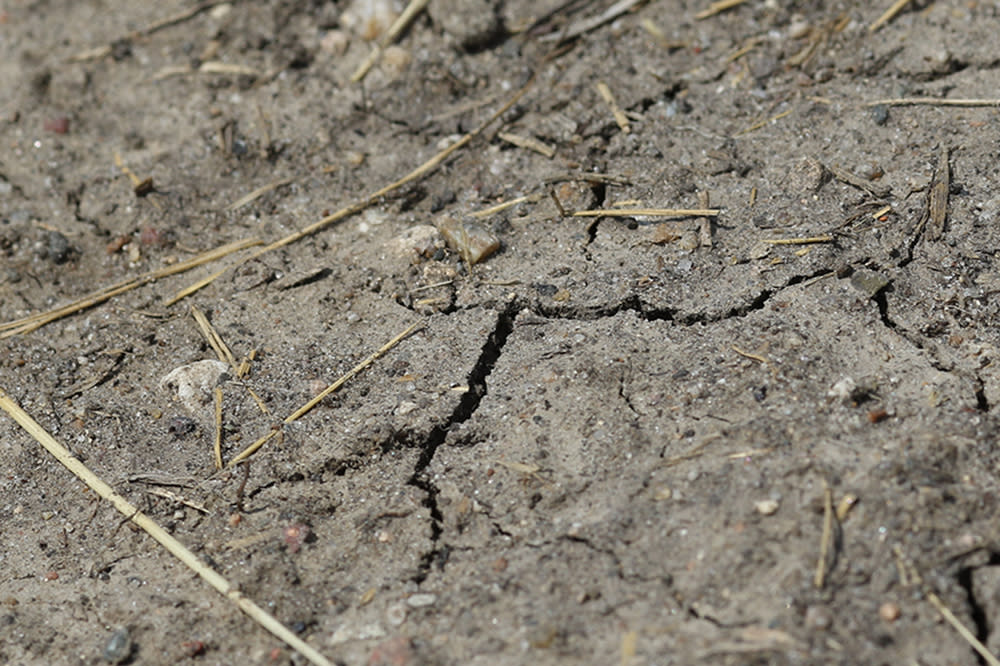Iowa’s water needs protection from aquifer raiders

Cracks in Iowa soil have resulted from drought conditions. (Photo by Jared Strong/Iowa Capital Dispatch)
Bubbling up beneath the surface of the Iowa Utility Board’s pending decision whether Summit Carbon Solution’s proposed pipeline is justified by “public convenience and necessity” is the equally critical question of whether granting permits allowing Summit to siphon significant amounts of public water resources meets the state’s legal standard of being “put to beneficial use . . . in the interest of the people.”
That’s the question recently raised by the Sierra Club-Iowa Chapter and a group of Iowa landowners. Using data from Archer Daniels-Midland’s carbon capture and sequestration project near Decatur, Illinois, this new report calculated that Summit Carbon’s pipeline would require 3.36 billion gallons of the state’s water annually – the equivalent of the annual drinking water needs of 529,0000 Iowans. Most of it would be drawn from deep bedrock aquifers that recharge slowly over decades.
The Iowa Renewable Fuels Association disputes these numbers. But Summit already has received a DNR water permit in Chickasaw County to withdraw up to 55.9 million gallons annually from a new limestone well drawing from the Devonian aquifer at the Homeland Energy Solutions ethanol plant near Lawler. Another water permit currently is pending from the Corn LP ethanol plant in Goldfield in Wright County for 27.7 million gallons per year.
If eminent domain isn’t a sufficiently compelling reason to cause Iowa regulators to hit the brakes on Summit’s carbon pipeline, the potential impact on Iowa’s future water resources should be. Persistent droughts, expansion of ethanol plants and the potential to produce sustainable aviation fuel, the volatility of corn prices, and the specter of climate change all raise the stakes for Iowa’s water assets.
Furthermore, the carbon capture pipeline isn’t the only emerging demand with a huge public water footprint. Computer data centers in Altoona, Council Bluffs, and West Des Moines suck up substantial amounts of water, and the rapid adoption of cloud-based storage and AI (artificial intelligence) will ramp up this consumption exponentially.
Iowa’s large livestock operations and meat processing plants already require significant water, along with growing Iowa’s sizeable corn crop. Other competing interests are likely to test the waters. A few years ago, Iowa turned down three requests by a northeastern Iowa mining company to ship water out of state.
Internet swallows big gulps
Water was a key component of the fledgling biofuels expansion in the early 2000s. Ethanol plants use significant amounts of water. According to the Nebraska Corn Board, it takes three gallons of water to produce one gallon of ethanol; over 11,000 liters of water are needed to make one liter of biodiesel from soybeans.
New water permits would be required at certain ethanol plant sites equipped to capture carbon and cool it into liquid before pumping it through pipelines to a North Dakota sequestration site. Most of this water used for cooling would evaporate into the atmosphere.
Data centers also require large volumes of water to keep their servers from overheating. In Altoona, one-fifth of the city water is consumed by the Meta data center – up to 1 million gallons per day. Altoona is considering a new water plant and two new wells tapping into the deep Jordan aquifer by 2026. Six West Des Moines data centers pull from the watersheds of the Raccoon and Des Moines rivers. According to a 2023 report, the Google center at Council Bluffs uses more water than any other in the U.S.
A proposed Google data center in Cedar Rapids may guzzle an estimated average of 200,000 gallons to over 1 million gallons daily. Apple also plans to build in Waukee.
Meta and Microsoft have claimed they will be “water-positive” in 2030. Apple is taking aim at it within the next 20 years. However, AI will be a new wild card. Microsoft’s ChatGPT-4 Open AI was “literally made next to cornfields west of Des Moines” claimed a top executive in a speech in May of 2023. University of California-Riverside researcher, Shoolei Ren, estimates that ChatGPT uses up to 500 milliliters of water (about a 16-ounce water bottle) every time it’s asked a series of five-50 prompts or questions. That’s a lot of water down the drain.
During the cold winter season, data centers can rely on outside air to vent heat. These systems begin to withdraw water (mostly treated drinking water) from a cooling tower when the temperature hits about 85 degrees Fahrenheit. With climate change, that may increasingly be commonplace.
In May 2020, Pattison Sand Co., which mines silica sand for oil and gas fracking near Clayton, Iowa, dropped its efforts for a permit to draw millions of gallons of water from wells on its property fed by the Jordan aquifer. It planned to pump 34 million gallons of water annually to ship by rail car to an Oregon company, Water Train, destined for cities and states in the western United States. Pattison already draws 2.1 billion gallons for its core business from aquifer-fed wells, and the Mississippi River.
The Jordan aquifer runs from NE to SW Iowa, and is a source of drinking water for 500,000 people. The state questioned where the water would go, and how it would be used. Pattison’s lack of response suggested that the application wouldn’t meet the legal standard of “beneficial use” and “in the interest of the people.” Pattison withdrew its latest appeal in 2021.
Increasing water pressure
In my former position as a farm editor, water issues created a steady flow of stories written from a national perspective for Successful Farming from 2003 to 2014, including:
Efforts to reduce overpumping of the Ogallala aquifer, the world’s largest underground water system, used to irrigate one-third of the U.S. corn crop and provide drinking water to eight states. Grassroot solutions for saving the aquifer continued at the 2024 Ogallala Aquifer Summit earlier this month.
Steps taken by the Great Lakes states to regulate approval of major water diversions outside of the Great Lakes Watershed and to set regulations on new commercial water uses;
The severe 2003 drought precipitating the agreement on a formula by Florida, Georgia, and Alabama for sharing the Apalachicola-Chattahoochee-Flint River system;
Fierce opposition to the Keystone XL’s oil pipeline’s proposed path atop of the Ogallala aquifer through Nebraska;
Emerging demands on freshwater supplies by hydraulic fracking.
My research and interviews for these stories led me to believe that water supplies across the U.S. were being drained at an unprecedented rate. Yet Iowa is a water-rich state. I never expected to write about threats to Iowa’s future water resources. But Storm Lake was forced to shut down its King’s Pointe Water Park during RAGBRAI in 2023 due to drought and concerns about the underlying Dakota aquifer; Osceola has had to restrict its residents’ water use, due to the low levels of West Lake caused by drought.
Restricting aquifer raiders and water hogs
This year the Iowa Legislature voted to spend $250,000 for a study of the state’s water resources by the Iowa Geological Survey at the University of Iowa. This would include mapping and assessing the conditions of Iowa aquifers, in addition to measuring the volume of ground water available, how quickly it replenishes and models for budgeting Iowa water supplies in the future. A hydrologist will be hired to conduct the study, which would need future appropriations to complete.
You can’t manage what you don’t measure. Makes sense, right? Irrigated acres increased 55% in Iowa from 2012 to 2022, according to the most recent Census of Agriculture. Setting state water priorities must factor in the competing needs of human consumption, food production, navigation, industry, energy production, wildlife, and recreation. Conserving water resources deserves the same priority as other national and state energy security concerns.
But launching Iowa’s first comprehensive water use study this year will achieve about as much as the state’s promise to study the need for an overhaul of the Area Education Agencies after the Legislature already passed Gov. Kim Reynolds’ unpopular overhaul plan. Too little, too late.
After all, Iowa already is sailing a leaky boat into uncharted waters. Summit Carbon is affiliated with many investors and corporations beyond Iowa, and their equity positions as well as their motives are murky. Lurking in the shadows of the pending pipeline decision is a question that resurfaced many times during the IUB hearings: Once the pipeline is built and the tax credits run out, what other future use might be on tap for the pipeline? Would it transport Iowa’s water for fracking oil and gas? Or, Iowa’s water supplies to irrigate the arid West?
Private companies shouldn’t be allowed to raid our state’s richest treasure next to our soils: water. Iowa cannot carelessly mortgage the future of its water wealth.
The issue of eminent domain is a matter of private property rights, and it forms one of the bedrocks of our democracy. The precious water stored in the bedrock aquifers below us is the property of all Iowans, and must be protected for generations to come.
This column first appeared on Cheryl Tevis’ blog Unfinished Business, and it is republished here via the Iowa Writers’ Collaborative.
Editor’s note: Please consider subscribing to the collaborative and its member writers to support their work.
The post Iowa’s water needs protection from aquifer raiders appeared first on Iowa Capital Dispatch.


